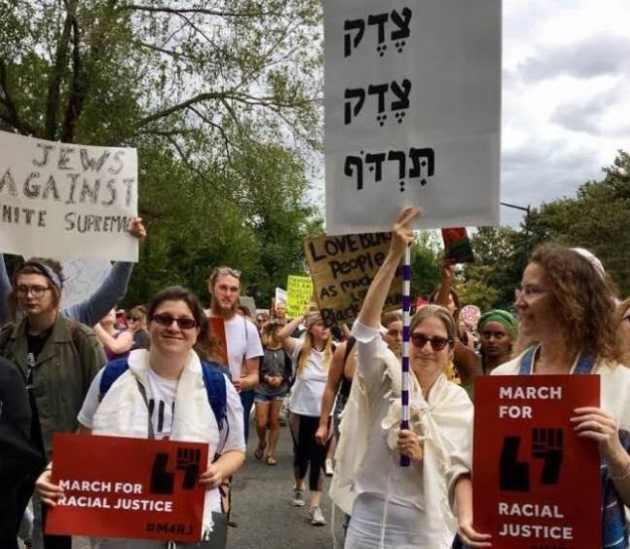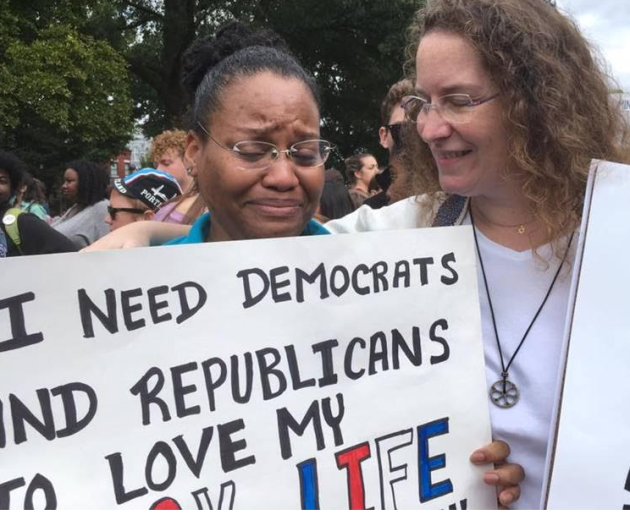The Lilith Blog 1 of 2
October 3, 2017 by Betsy Teutsch
Marching for Racial Justice on Yom Kippur

Photo credit: Susan Wasserkrug. The “tzedek, tzedek tirdof” was created by Lynna Schaefer. Carrying the red sign on the left: Rabbi Amber Powers. Carrying the Tsedek sign: Betsy Teutsch. Carrying the red sign on the right, Lynna Schaefer
Ironically, I heard about the March for Racial Justice via an explosion of disapproval and upset on the Sisters of Salaam Shalom Facebook group. Member after member expressed outrage that the march’s organizers had ignored Jewish needs when scheduling the march.* Learning that the march was sparked in response to the acquittal of Philando Castile’s killing by a police officer, streamed by his girlfriend sitting next to him in his car, I instantly decided to go.
Marching as a white Jewish ally to African-Americans traumatized by generations of systemic brutality struck me as a constructive, stirring way to observe Yom Kippur. September 30th was also the anniversary of the Elaine Massacre in 1919.
Full disclosure: After 40+ years of sitting in shul by my rabbi husband’s side on holidays and 52 shabbat mornings a year at our Minyan, Dorshei Derekh, I get pretty restless spending all day in shul on Yom Kippur. Opportunities to pray with my feet appeal to me.
Yes, Jews were allies in the Civil Rights era. But we can’t just rest on that cred. That was in my childhood—and I am 65 years old!
My primary intersectional identity as an adult has been as Jewish, female, and upper middle class. I gave very little thought to how much privilege flows to me as a white person.
Two examples come to mind. We bought a huge, beautiful home in Mt. Airy, an integrated neighborhood in Philadelphia, in 1986. We could afford so much house because the neighborhood is integrated. This lowered property values. Comparable homes in the whiter suburbs were way costlier, as were the property taxes to pay for their great schools. Racism lowered our overhead.
Why were we willing to move to a neighborhood with crappy schools? Because we sent our kids to Jewish Day School. We did so because we wanted our kids to have a solid Jewish education but, de facto, it allowed us to ignore our city’s struggling public (majority poor and black) school system.
Benefiting from racism is not the same as being racist, of course, but we ask forgiveness for acts both conscious and those performed unwittingly. Marching for racial justice doesn’t repair past damage. But it is at least a modest act of public atonement.
The march was wonderfully positive, a glorious sunny day of white people and black people collectively denouncing injustice and vowing to do better.

Photo credit: Marjie Hashmall George. Left: Regina Marie Foertsch, right Lynna Schaefer.
Lynna Schaefer and I met on the M4RJ listserv when I invited Jews who wanted to observe Yom Kippur at the march to join me. She created a beautiful, highly visible sign “Justice Justice Shall You Pursue” sign and brought it all the way from Albany. We arranged to meet at the march, dressed for Yom Kippur in white clothing, kippot, and tallitot. We were a magnet for a tribe of other Jewish marchers—rabbis, secular Jews, congregants from the D.C .area, and Jewish students. I was even interviewed by Rachel Chason of the Washington Post.
“I find marching is a very sacred experience,” said Teutsch, of Philadelphia. “You’re with a large collective. This is a chance to express Yom Kippur in a different way.”
Fellow marchers thanked us for coming and wished us a Happy New Year. We felt very supported and respected. But the moment that brought the whole day home was when Regina Marie Foertsch, a middle-aged African American, reacted to seeing us dressed for synagogue. “You came on Yom Kippur!” she gasped. “I can’t believe it!” After taking it in, she began to weep. She and Lynna embraced; my fellow marchers and I felt the full power of the simple act of our showing up.
*A beautiful apology from the march’s organizers to the Jewish community can be found here.
The views and opinions expressed in this article are the author’s own and do not necessarily reflect those of Lilith Magazine.
 Please wait...
Please wait...